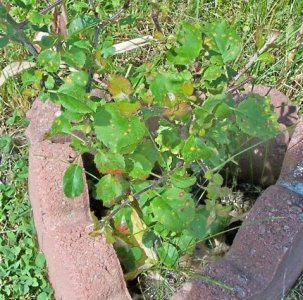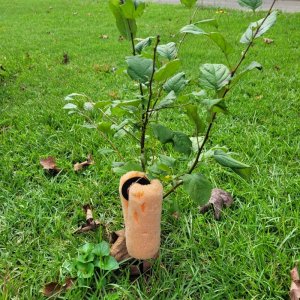I sent a photo to Cornell Cooperative Extension and was surprised I received an answer so quickly:
Hi Debbie,
It looks like you have cedar apple rust. Below is a little background on it and then beneath that is how to handle it. Sadly, we are too far into Spring to spray a fungicide as you want to spray right before the buds begin to open.
Cultural control practices
Tolerate leaf spots and fruit infection on apples, hawthorns, serviceberry and other plants in the Rosaceae family. They do not significantly affect the health of the tree if leaf loss does not occur.
- Do not plant eastern red cedar and juniper plants within a few hundred yards of susceptible Rosaceae plants. This will reduce disease problems but not completely eliminate them.
- Inspect nearby juniper and red cedar trees in late winter or early spring. Prune and remove brown, woody galls found before orange, gelatinous structures form in the spring. This will help reduce the level of infection on nearby Rosaceae plants.
- Prune and remove infected twigs or branches on Rosaceae plants if they occur.
Fungicides
Fungicides are not recommended to protect trees from infection with cedar apple rust and related rust fungi. Trees and shrubs often tolerate infection.
- There are no fungicides available to home gardeners that can be used on trees that produce fruit that will be eaten by people.
- Fungicides are available to protect trees and shrubs that are for ornamental purposes only.
- Fungicides with the active ingredient Myclobutanil are most effective in preventing rust. Copper and sulfur products can be used as well.
- Fungicides are only effective if applied before leaf spots or fruit infection appear
- Spray trees and shrubs when flower buds first emerge until spring weather becomes consistently warm and dry.
- Monitor nearby junipers. Fungicides must be applied to crabapple, hawthorn, and other ornamental Rosaceae plants when gelatinous, orange, spore-producing structures appear on galls and branches.
Trees and shrubs in the Rosaceae family are highly attractive to bees, birds, and other wildlife. Avoid using fungicides if possible.
CAUTION: Mention of a pesticide or use of a pesticide label is for educational purposes only. Always follow the pesticide label directions attached to the pesticide container you are using. Be sure that the area you wish to treat is listed on the label of the pesticide you intend to use. Remember, the label is the law.


